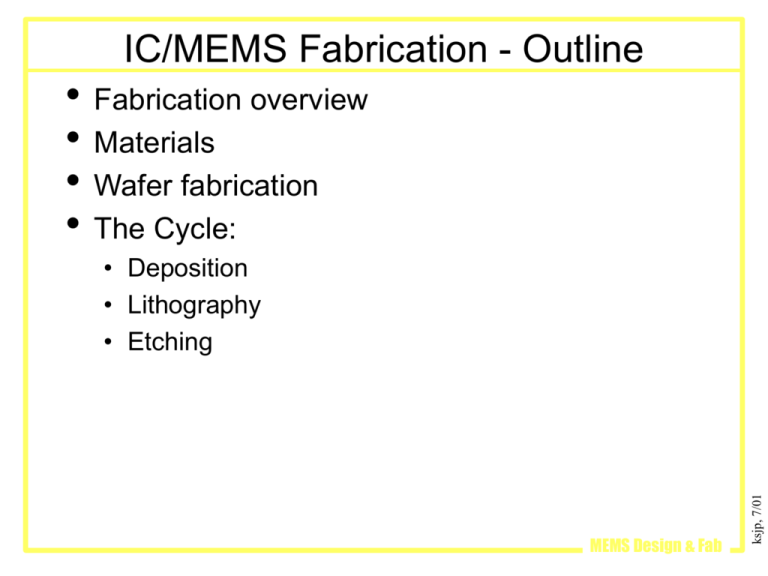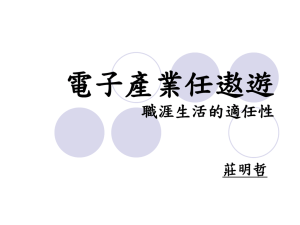Fab1
advertisement

IC/MEMS Fabrication - Outline • Fabrication overview • Materials • Wafer fabrication • The Cycle: MEMS Design & Fab ksjp, 7/01 • Deposition • Lithography • Etching Fabrication • • • IC Fabrication • Deposition • Spin Casting • PVD – physical vapor deposition • CVD – chemical vapor deposition • Lithography • Removal • Wet etching • Plasma etching Bulk Micromachining Surface Micromachining • MUMPS DRIE – deep reactive ion etch MEMS Design & Fab ksjp, 7/01 • Materials • • • • Single crystal silicon – SCS • Anisotropic crystal • Semiconductor, great heat conductor Polycrystalline silicon – polysilicon • Mostly isotropic material • Semiconductor Silicon dioxide – SiO2 • Excellent thermal and electrical insulator • Thermal oxide, LTO, PSG: different names for different deposition conditions and methods Silicon nitride – Si3N4 • Excellent electrical insulator Aluminum – Al • Metal – excellent thermal and electrical conductor MEMS Design & Fab ksjp, 7/01 • Silicon properties • Semiconductor • Electrical conductivity varies over ~8 orders of magnitude depending on impurity concentration (from ppb to ~1%) • N-type and P-type dopants both give linear conduction, but from fundamentally different mechanisms • N-type touching P-type forms a diode • Cubic crystal MEMS Design & Fab ksjp, 7/01 • Diamond lattice • Anisotropic mechanical properties MEMS Design & Fab ksjp, 7/01 Diamond Lattice MEMS Design & Fab ksjp, 7/01 Periodic Table Band Structure of Electron Energies • http://www.physics.udel.edu/wwwusers/watso • (not exactly right, but gives some intuition) MEMS Design & Fab ksjp, 7/01 • n/scen103/99s/clas0416.html Bohr atom, Pauli exclusion principle MEMS Design & Fab ksjp, 7/01 Band structure of Semiconductors MEMS Design & Fab ksjp, 7/01 Conductors, insulators, semiconductors Doping semiconductors ------ - - - - -o- • Electrons (negative, N-type) • Holes (positive, P-type) MEMS Design & Fab ksjp, 7/01 • Two different types of conduction Diodes V+ N P V- V- N P V+ Current exponentially dependent on voltage pA to kA in ~1V MEMS Design & Fab ksjp, 7/01 Tiny current ~pA Silicon wafer fabrication Taken from www.egg.or.jp/MSIL/english/index-e.html MEMS Design & Fab ksjp, 7/01 • Silicon wafer fabrication – slicing and polishing Taken from www.egg.or.jp/MSIL/english/index-e.html MEMS Design & Fab ksjp, 7/01 • Process Flow • Integrated Circuits and MEMS identical • Process comlexity/yield related to # trips through central loop Wafers Lithography Etch Chips MEMS Design & Fab ksjp, 7/01 Deposition Deposition Issues - Compatibility • Thermal compatibility • Thermal oxidation and LPCVD films are mutually compatible • Thermal oxidation and LPCVD are not compatible with polymers (melting/burning) and most metals (eutectic formation, diffusion, furnace contamination) • Topographic compatibilitiy MEMS Design & Fab ksjp, 7/01 • Can not spin-cast over large step heights • Distributed-source deposition over deep trenches leaves keyholes Deposition Issues - Conformality • A conformal coating covers all surfaces to a • Conformal Planarizing Non-conformal MEMS Design & Fab ksjp, 7/01 • uniform depth A planarizing coating tends to reduce the vertical step height of the cross-section A non-conformal coating deposits more on top surfaces than bottom and/or side surfaces Etching Issues - Anisotropy • Isotropic etchants etch at the same rate in every direction mask An-isotropic MEMS Design & Fab ksjp, 7/01 Isotropic Etching Issues - Selectivity • Selectivity is the ratio of the etch rate of the • • target material being etched to the etch rate of other materials Chemical etches are generally more selective than plasma etches Selectivity to masking material and to etchstop is important Etch stop MEMS Design & Fab ksjp, 7/01 Mask target Spin Casting MEMS Design & Fab ksjp, 7/01 • Viscous liquid is poured on center of wafer • Wafer spins at 1000-5000 RPM for ~30s • Baked on hotplates 80-500C for 10-1000s • Application of etchants and solvents, rinsing • Deposition of polymers, sol-gel precursors Physical Vapor Deposition - Evaporation • Evaporated metals in a tungsten crucible • Aluminum, gold • Evaporated metals and dielectrics by electron-beam • Refractory metals (e.g. tungsten) • Dielectrices (e.g. SiO2) • Typically line-of-sight deposition • Very high-vacuum required to prevent MEMS Design & Fab ksjp, 7/01 oxidation of e.g. aluminum Physical Vapor Deposition - Sputtering • Sputtered metals and dielectrics • Argon plasma sputters material (small #s of atoms) off target • Ejected material takes ballistic path to wafers • Typically line-of-sight from a distributed MEMS Design & Fab ksjp, 7/01 • source Requires high vacuum depending on material Thermal Oxidation O2 Silicon is consumed as the silicon dioxide is grown. Growth occurs in oxygen and/or steam at 8001200 C. ~2um films are maximum practical MEMS Design & Fab ksjp, 7/01 Silicon SiO2 Silicon Thermal Oxidation • Oxidation can be masked with silicon nitride, which prevents O2 diffusion Silicon nitride MEMS Design & Fab ksjp, 7/01 SiO2 Silicon Chemical Vapor Deposition • • • Gases dissociate on surfaces at high temperature Typically done at low pressure (LPCVD) rather than atmospheric (APCVD) LPCVD pressures around 300mT (0.05% atmosphere) Moderate Temperatures • 450 SiO2 • 580-650 polysilicon • 800 SixNy Very dangerous gases • Silane: SiH4 • Arsine, phosphine, diborane: AsH3, PH3, B2H6 MEMS Design & Fab ksjp, 7/01 • • MEMS Design & Fab ksjp, 7/01 LPCVD Systems Wet etching MEMS Design & Fab ksjp, 7/01 • Extremely selective • Typically isotropic • Not widely used MEMS Design & Fab ksjp, 7/01 Plasma Etching MEMS Design & Fab ksjp, 7/01 Plasma Etching MEMS Design & Fab ksjp, 7/01 Plasma Etchers ksjp, 7/01 MEMS Design & Fab MEMS Design & Fab ksjp, 7/01 LAVA/SAMPLE2D – www.eecs.berkeley.edu/~neureuth MEMS Design & Fab ksjp, 7/01 Line-of-sight deposition Step coverage problems • Re-entrant sidewall angles cause MEMS Design & Fab ksjp, 7/01 discontinuity in metal lines MEMS Design & Fab ksjp, 7/01 Hemispherical source improves step coverage But isn’t perfect - Keyhole effect MEMS Design & Fab ksjp, 7/01 • Hemispherical/Isotropic deposition MEMS Design & Fab ksjp, 7/01 Etching simulation Summary • Conformality of deposition is critical • LPCVD and thermal oxidation temperatures MEMS Design & Fab ksjp, 7/01 • • limit the materials that can be used Selectivity of etchants is important Anisotropy of etchants is important



